The longest night of my life was on a cold camping trip. I didn’t sleep at all! Since then I’ve refined my approach on hundreds of camping trips and figured out how to stay warm in a tent in all kinds of weather.
This post has over 40 tips for staying warm while camping. I’m mostly a backpacker and road tripper, so these tips are for people who camp in a tent both in the backcountry and at drive-in campgrounds.
But why trust my advice? I’ve been camping my whole life and backpacking for over 20 years. (I’n 2021’ve also written two backpacking guidebooks.) I camp a few dozen nights each year, often in the wet and cold Canadian mountains.
I also worked in an outdoor store for three years, and then for six years at the head office of a large outdoor retailer. While I was there I learned so much about outdoor gear and skills that I wrote training materials for the staff.
So you can trust that this post has real, tried-and-tested advice about how to stay warm in a tent. No BS Pinterest hacks here 🙂
This is a sensitive wilderness area. Learn how to Leave No Trace to keep the wilderness wild. Make sure you are prepared by bringing the 10 Essentials. Get ready for adventure with this checklist of things to do before every hike.
Hey there: Some of the links in this post are affiliate links, which means I earn a small commission at no cost to you. Thanks for your support. -Taryn
Choose the Right Tent
With the tips in this article, you can stay warm in any tent. However, the type of tent you choose determines how easy it is to keep warm.
Small tents are warmer: The bigger the tent, the more space to heat. Small two- or three person- tents are the easiest to keep warm. Big tents you can stand up in will be harder to keep warm.
Four-season tents are warmer: Since they are designed for winter, four-season tents are easier to keep warm. They have fewer mesh panels and are built to withstand heavy wind and snow. But, unless you are a mountaineer or do a lot of backcountry winter camping, most people will be fine in a three-season tent.
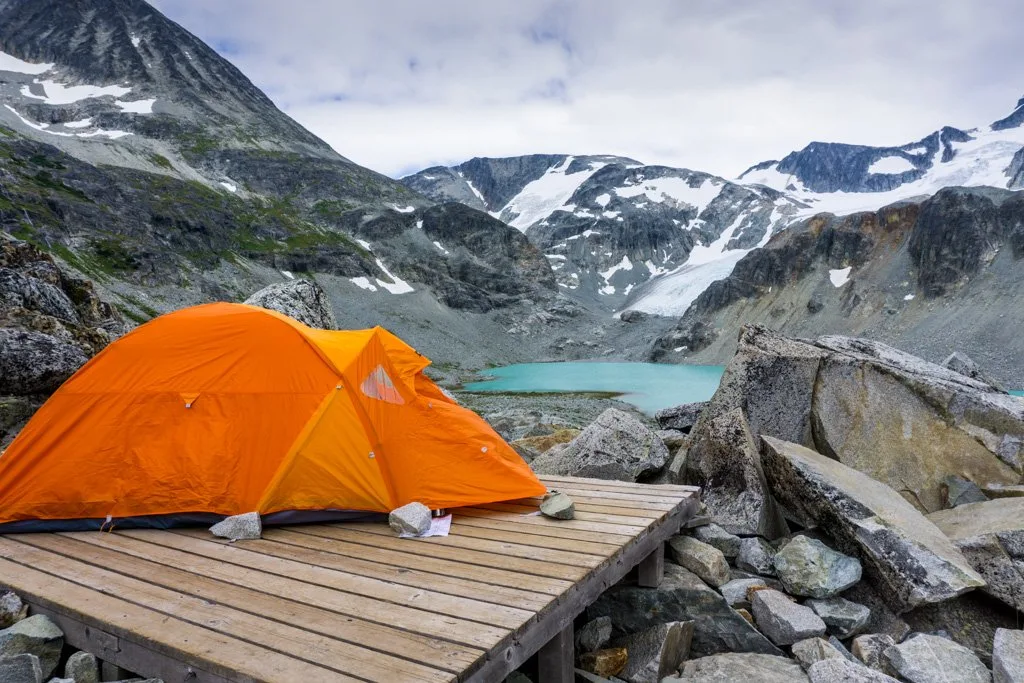
Pick a Good Campsite
Where you put your tent can make a big difference when it comes to keeping warm while camping.
Choose a campsite out of the wind: If the cold wind howls all night, it will blow into even the most windproof tent. And that will make you cold. Pitch your tent in a clump of trees or behind a natural feature like a ridge.
Soak up the sun: If possible, choose a campsite that gets the morning sun. It will be much easier to get out of bed in the morning when you’re warmed by its rays!
Stay low: It is often much colder at higher elevations in the mountains. I like to camp low, then hike high during the day.
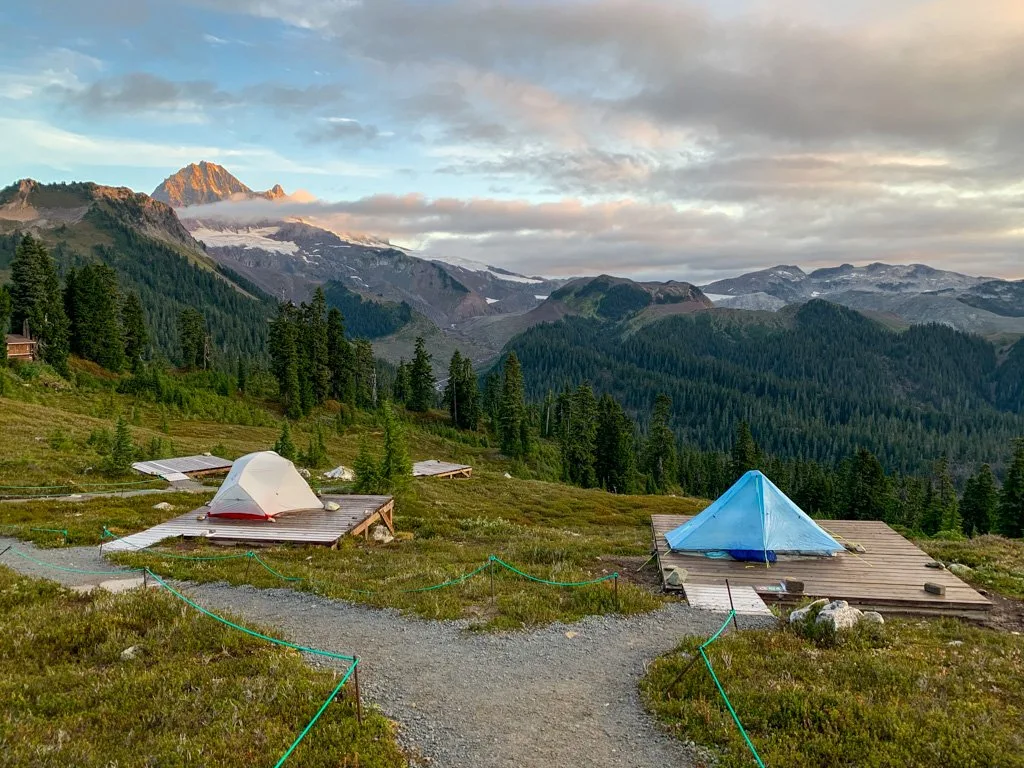
Fight Condensation
When it comes to staying warm in a tent, condensation is the enemy. You might be tempted to close the tent windows and block all air from entering.
But when you sleep, you exhale water vapor. If that water vapor doesn’t vent out of the tent it will settle on top of you and your sleeping bag as condensation. You will wake up cold and damp. No fun!
Pitch your tent tightly: Make sure you tighten up all the attachment points for your fly and stake out your tent well. Your tent is designed to have moisture pass through the mesh or fabric inner panels. Then it condenses on the underside of your tent fly. From there, it runs down to the ground. When you don’t pitch your tent tightly, the fly touches the mesh, which makes condensation drip back inside the tent.
Vent your tent: It might sound counter-intuitive to keep your tent open, but venting condensation can keep you warmer and more comfortable. If your tent has a vent over the door or in the roof, leave it open a little bit – vents up high work best. You can also leave your door partly unzipped.
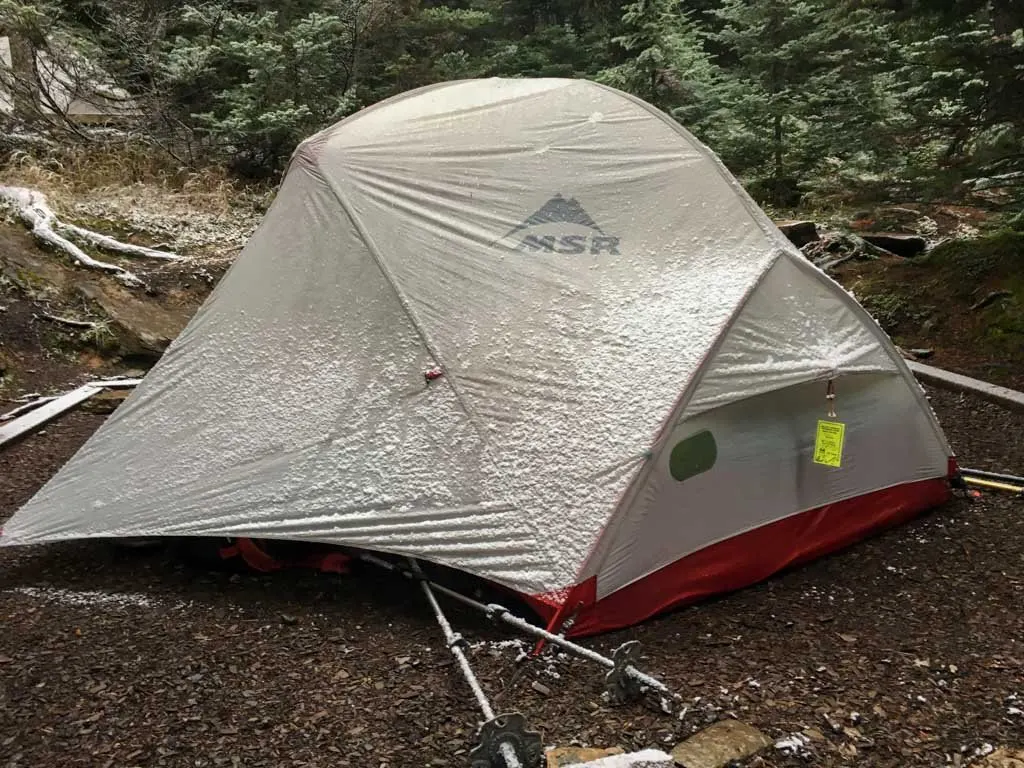
Bring a Warm Sleeping Bag
This one seems like a no-brainer: a warm sleeping bag will keep you warm, right? Well, yes, of course. But… what does “warm” mean when it comes to sleeping bags?
Check the temperature rating: Most high-end sleeping bags from respected brands have a certified temperature rating verified by independent testing. When buying a sleeping bag, check to see if has an EN or ISO temperature rating. If the sleeping bag doesn’t have this rating, any claim that the manufacturer makes about its temperature suitability is just marketing hype. (And in my experience the sleeping bag won’t be nearly as warm as they claim.)
Read temperature ratings carefully: Each bag has two ratings: comfort and limit. If you are worried about being cold in your tent, use the comfort rating. I sleep cold and find that I am the warmest if I use a sleeping bag with a comfort rating that is 10-20°F (5-10°C) colder than the coldest temperature I expect to encounter.
Check the weather forecast: You need to know how cold it will be so you can figure out what temperature sleeping bag you will need. City forecasts are useless when you’re camping. Use these weather apps for hikers instead.
Use a sleeping bag with a hood: Keeping your head warm goes a long way toward staying warm in a tent. Pull the adjustments on your sleeping bag to snug the hood around your face so you don’t let cold air in. (But make sure your nose and mouth are out so you can breathe. And so you don’t trap condensation inside your sleeping bag.)
Look for a sleeping bag that keeps out drafts: Higher-end sleeping bags designed for cold weather will have extra baffles of insulation sewn into them to keep out cold air. Usually, this means a draft tube (a long baffle behind the zipper) and a draft collar (a bib-like flap that goes around your neck).
Choose a bag with a snug fit for your body type: If you have lots of empty space inside your sleeping bag, that is just more air you need to keep warm. A mummy-shaped sleeping bag will keep you warmer than a rectangular one. Short or petite people should look for small-sized sleeping bags. And if you are a bigger or taller person, make sure your sleeping bag isn’t too tight. If you press against the sides of your sleeping bag too much, you compress the insulation and it won’t keep you as warm. Look for bags in long or wide sizes.
Tuck tomorrow’s clothing into your sleeping bag: If your bag isn’t too snug, fill any empty space in the bag with dry clothing. It will keep you warm by cutting down on air space, and you’ll have warm clothing to put on in the morning.
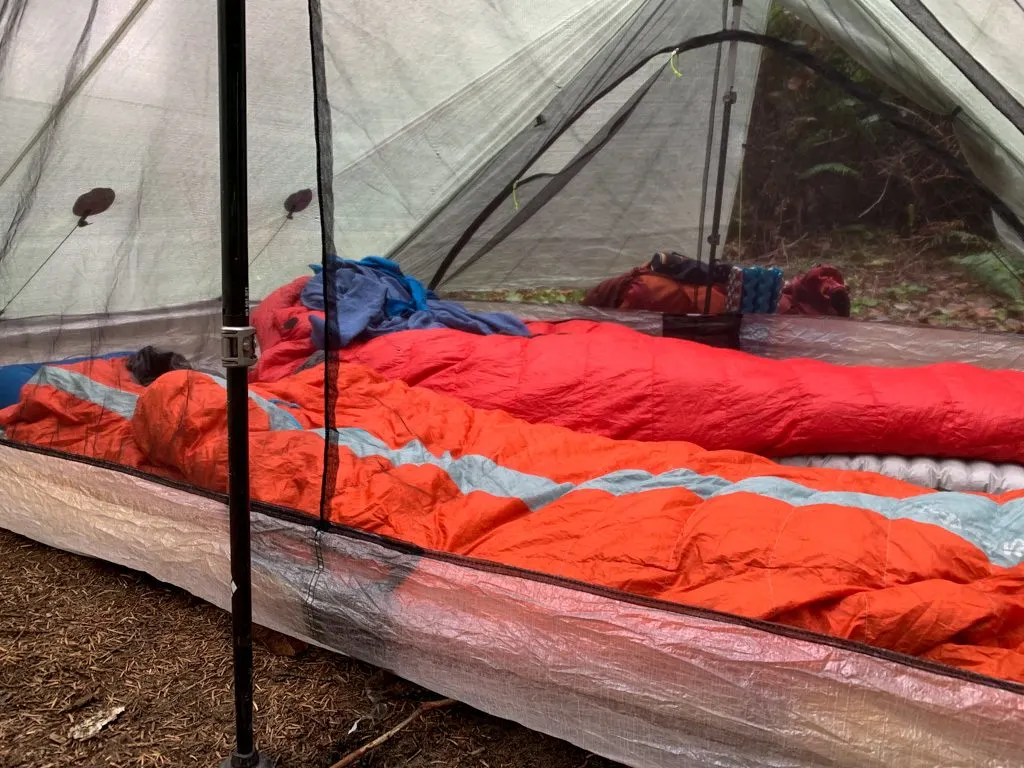
Add Layers to Your Sleeping Bag
If your sleeping bag isn’t warm enough, you can always add layers to make it warmer. However, keep in mind that the suggestions for layers (below) do not have tested temperature ratings like sleeping bags do, so it can be hard to tell how much warmth they add.
Use a sleeping bag liner: A fleece sleeping bag liner can add warmth to your sleeping bag (up to about 12°F/6°C). Ones with Thermolite (an insulating fabric) can add up to 25°F/13°C. Lightweight sleeping bag liners made of cotton, silk, or synthetics are designed to wick sweat and keep the inside of your sleeping bag clean. They don’t add any warmth.
Use an overbag: An overbag is basically a sleeping bag that is cut to fit over top of another sleeping bag to add more warmth. Since it goes outside, you don’t risk getting squished and tangled inside your sleeping bag the way you do with a liner. Over bags are considered niche gear and are not as popular as they used to be, so they can be hard to find.
Add a quilt: Quilts are trendy right now. You can get all kinds of quilts from basic, inexpensive rectangular ones to fancy, ultralight tapered ones. Layering a quilt over your sleeping bag can definitely help keep you warm in a tent. My husband and I often bring a basic rectangular down quilt on cold trips, then drape it over both of our sleeping bags.
Add a blanket: A fleece or wool blanket can add a lot of warmth to your sleeping bag, but they can be bulky and heavy, especially in the case of wool ones.
Myth Busted: Space Blankets Add Warmth
Mylar space blankets keep you warm by reflecting your body heat back to you. BUT they also trap moisture. That means that as you sleep, all the water vapor from your breath and body will condense on the underside of the space blanket. You might be a little bit warmer in the short term, but you will be wet too, and that will make you colder.
Space blankets are great to use in an emergency when you don’t have anything else. But you shouldn’t plan to use one layered over your sleeping bag as part of your sleep system.
Use an Insulated Sleeping Pad
Most beginner campers focus on getting a warm sleeping bag. But getting a warm sleeping PAD is way more important. The ground is cold, and that cold seeps into your body all night long. If you’re going to splurge on any gear to keep you warm in a tent, make it a good sleeping pad.
Skip the air mattress: Traditional blow-up air mattresses may be comfortable, but they offer no insulation. All that air underneath you will just make you cold.
Use an insulated sleeping pad: Traditionally, the only insulated sleeping pads available were made with foam. But now you can also buy sleeping pads insulated with down, synthetic fibres, or even space-age foil.
Look for the R-value: This value is a measure of insulation – the higher the value, the more insulation it provides. Most high-end insulated sleeping pads from respected brands have a certified R-value verified by independent testing. When buying a sleeping pad, check to see if has an R-value. If it doesn’t have an R-value, any claim that the manufacturer makes about its insulation is just marketing hype (and likely misleading).
Choose a higher R-value: If you sleep cold, look for sleeping pads with a higher R-value. In general, R-values under 2 are good for warm weather. If you expect cold weather, an R-value of about 4 is good. For freezing temperatures, look for an R-value of 6. I sleep cold so in the summer I use an Exped Ultra 5R (R-value of 4.8), and the rest of the year I use a Therm-a-Rest NeoAir Xtherm (R-value of 6.9).
Use two pads: If your sleeping pad isn’t warm enough, you can layer a second sleeping pad underneath. A simple and inexpensive closed-cell foam pad like the Therm-a-Rest Z-Lite can add an R-value of 1 to 2.
READ NEXT: 300+ Hiking Terms Explained: A Hiking Glossary
Dress in Warm Layers of Clothing
When you are camping or hiking, dressing in layers is a great way to regulate your temperature. You can add or remove layers as you get colder or warmer. Make sure your clothing isn’t too tight so that it doesn’t reduce blood flow.
Start with a Base Layer: Also called long underwear, base-layers wick sweat and trap heat against your body. Look for base layers made with merino wool or synthetics. Choose ones rated midweight or heavyweight. Avoid silk, which is good for comfort and moisture management, but not warmth. And definitely don’t wear cotton which absorbs moisture and doesn’t offer good insulation.
Add a Mid Layer: I like to bring fleece pants to layer over my long underwear bottoms on chilly trips. I also wear a fleece jacket or an insulated puffy jacket (either down or synthetic).
Wear Dry Clothes to Bed: Don’t wear damp or sweaty hiking clothes to bed. They will just keep you cold all night. Change into a dedicated set of sleeping clothes.
Keep Your Head and Neck Warm: Wear a warm beanie (toque for Canadians) to insulate your head. Look for ones made of wool or fleece. I like base layer tops with hoods that I can layer over my hat. Don’t forget about your neck. Layer on a fleece or merino wool buff (also known as a neck tube or neck gaiter).
Insulate Your Feet: It’s easy to get cold feet when camping. Bring a dedicated pair of warm fleece or wool socks. If you find you get really cold feet, a pair of insulated booties can work wonders.
Bring gloves or mittens: I like to sleep in merino wool or fleece gloves to stay warm in a tent. If it’s really cold, I wear insulated mittens since they are warmer than gloves (and I don’t need dexterity when I’m sleeping).
Myth Busted: Sleeping Naked Makes You Warmer
A common piece of advice for staying warm in a tent is to sleep naked inside your sleeping bag. Unfortunately, it doesn’t work.
Sleeping bags trap your body heat, which keeps you warmer. If you wear warm, dry clothing to sleep in, that will let you trap even more body heat, keeping you even warmer than if you were naked.
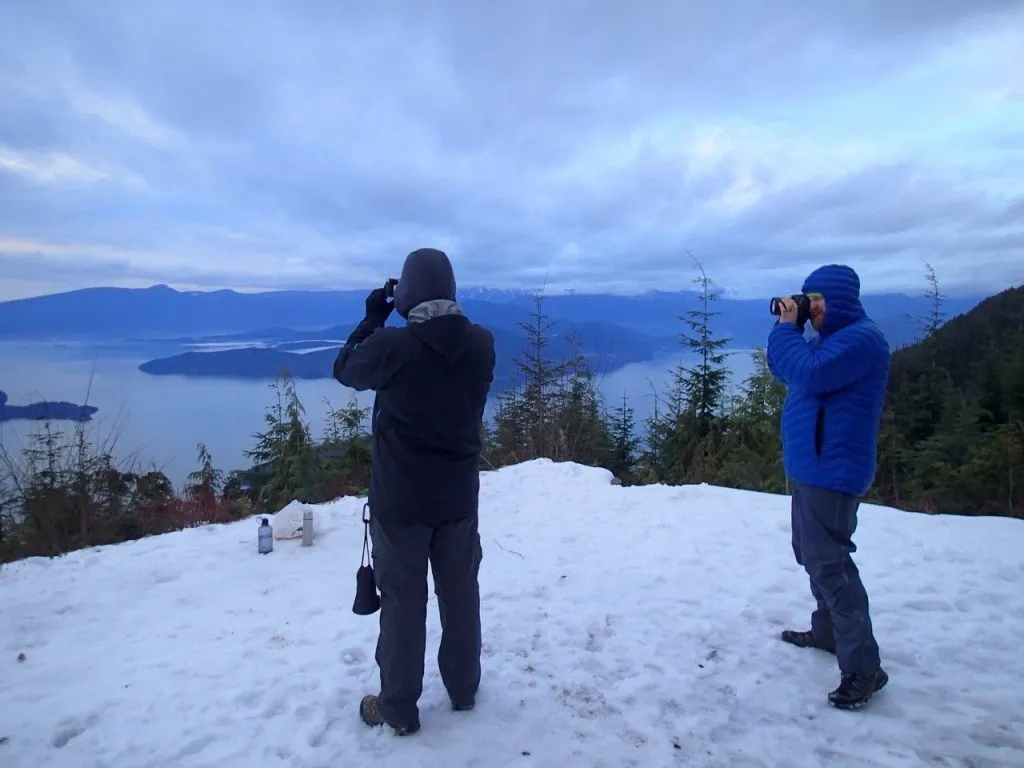
READ NEXT: What to Wear Winter Hiking and Snowshoeing
Make Sure You’re Warm Before You Go to Bed
If you are cold when you get in your sleeping bag, it will take a long time to warm up. Sleeping bags work by keeping the body heat you generate close to you. So make sure you are warm before you go to bed.
Layer up before you get cold: Don’t wait until you are shivering to put on more layers. If you are hanging around camp, put on your warm clothing before you feel the cold.
Do some light exercise: To make sure I’m really warm before I go to bed, I often do a few jumping jacks or jog in place. (An impromptu dance party is also fun!) This gets your heart rate up and raises your body temperature a little bit. Just be careful not to overdo it and get sweaty!
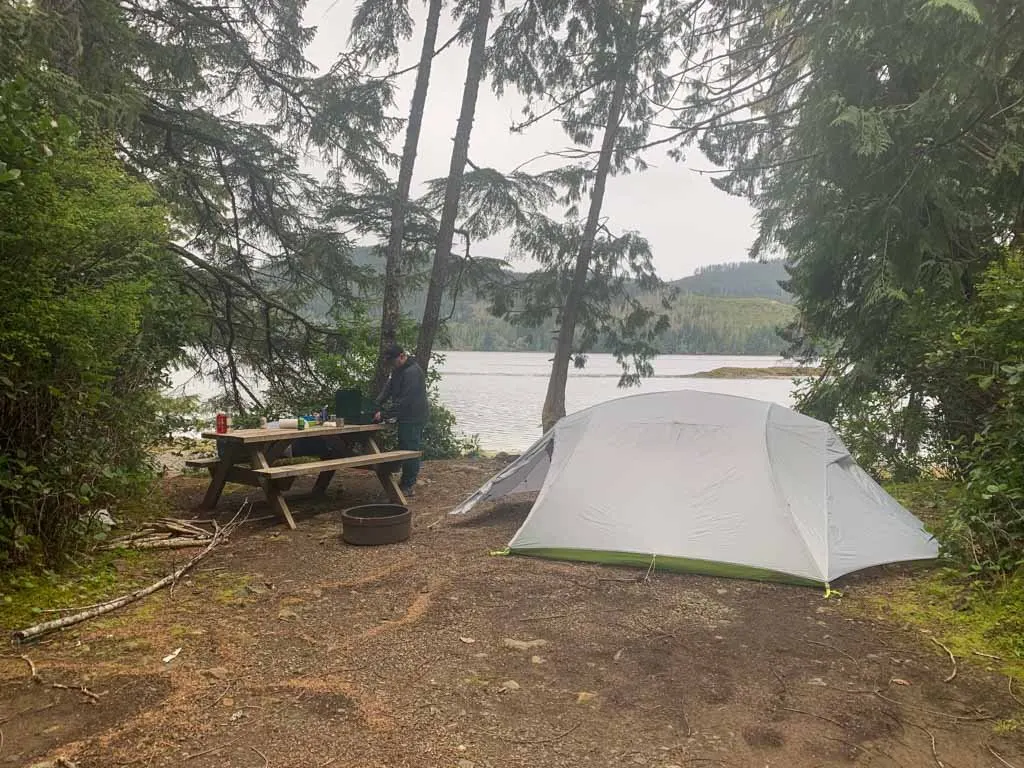
Eat and Drink Things That Warm You Up
Eat a high-calorie hot meal: Warm yourself up from the inside with a hot meal. Extra calories mean extra warmth from digestion.
Choose foods high in fat and protein: Your body uses a bit more energy to digest these foods, and that can make you feel a bit warmer.
Drink hot beverages: Hot chocolate, apple cider, tea and coffee can help raise your temperature a little bit. But like a warm meal, the main benefit is that they boost morale. (Avoid caffeinated tea and coffee. While caffeine can stimulate your metabolism, and increase your body temperature, it will just keep you awake all night!)
Avoid dehydration: When you are dehydrated, you can feel colder. Drink lots of liquids.
Myth Busted: Alcohol Makes You Warmer
Having a hot toddy or a shot can make you feel warm as the alcohol slides down your throat, but it actually lowers your body temperature.
That is because alcohol dilates your blood vessels, bringing blood to the surface of your skin. That makes you feel warm in the short term, but in the long term, it cools you down since that extra blood is exposed to cooler temperatures.
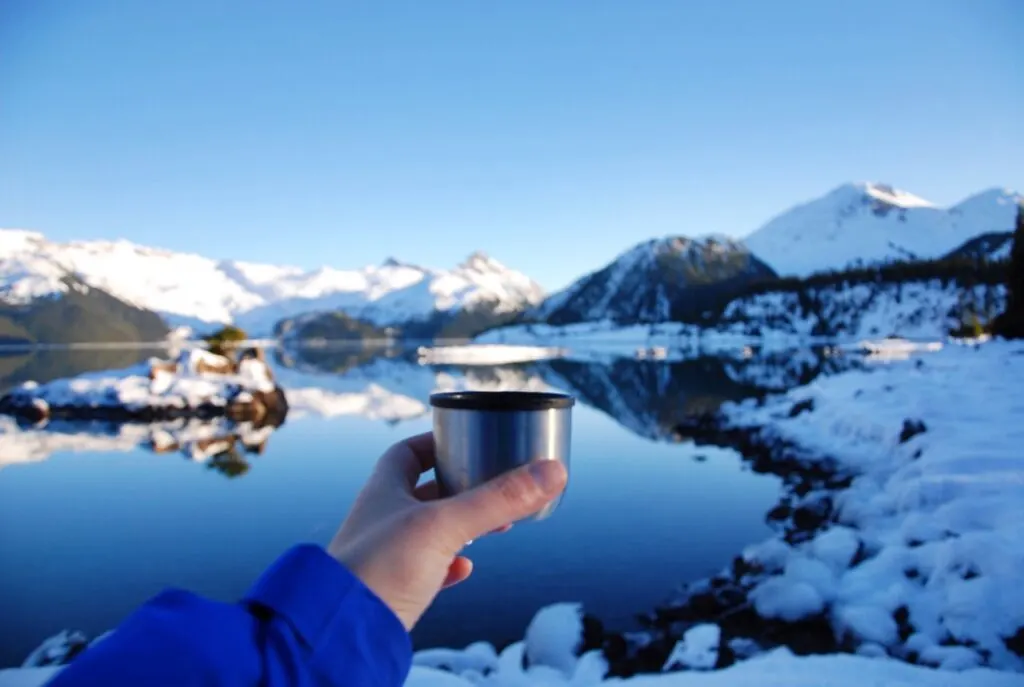
READ NEXT: How to Choose the Best Backpacking Meals
Add a Heat Source
So far, I’ve focused on tips for retaining your body heat to keep you warm in a tent. But you can also add in an external heat source for even more warmth.
Share your tent: Sleeping alone in a tent is much chillier than sharing with a friend or family member since you benefit from each other’s body heat.
Use a hot water bottle: A hot water bottle cradled against your core will add warmth to your sleeping bag for hours. You can also use a Nalgene bottle wrapped in a t-shirt. Just make sure the lid is on tight!
Bring hand and toe warmers: Hand and toe warmers can help heat up chilly extremities. You can buy disposable chemical warmers or reusable ones.
Use an electric blanket or space heater: If you have access to power, a small electric space heater or an electric blanket can add lots of heat. But be careful as frayed or loose wires can spark fires and sustained heat directly against the fabric of your tent or sleeping bag can melt it.
Myth busted: Propane Heaters are a Good Way to Heat a Tent
While many of propane camping heaters are marketed as tent heaters, if you read the info that comes with them, they say that they are not safe to be used indoors or in enclosed spaces. As well, the safety info says you can’t run them while you sleep.
That is because there isn’t enough ventilation and the carbon monoxide they produce can kill you. As well, they produce a lot of water vapor, which causes condensation issues inside the tent. And lastly, they include an open flame, which can start a fire.
I’ve also read reviews that said that these heaters don’t pump out that much heat and you will only really be warm if you are right next to the heater.
Unfortunately there are tons of companies out there promoting propane heaters as tent heaters. There are also lots of ill-informed blog posts suggesting you use a propane tent heater. Please don’t. It’s so dangerous and not worth it.
Bring a Thermometer
For the last few years, I’ve brought a thermometer on every hiking and camping trip. I make notes about the temperature and weather, along with the gear I brought. That way, I can learn what gear worked and what didn’t, then apply that knowledge on my next trip.
For a long time, I just used this basic mini-thermometer.
But recently, I upgraded to the digital Thermodrop. It stores the highest and lowest temperature since the last time it was turned on. That means I don’t have to check my thermometer in the middle of the night to know how cold it was.
In the future, I might even splurge on the Kestrel Drop, which logs temperature, humidity, and dew point, then displays it on graphs you can view via an app.
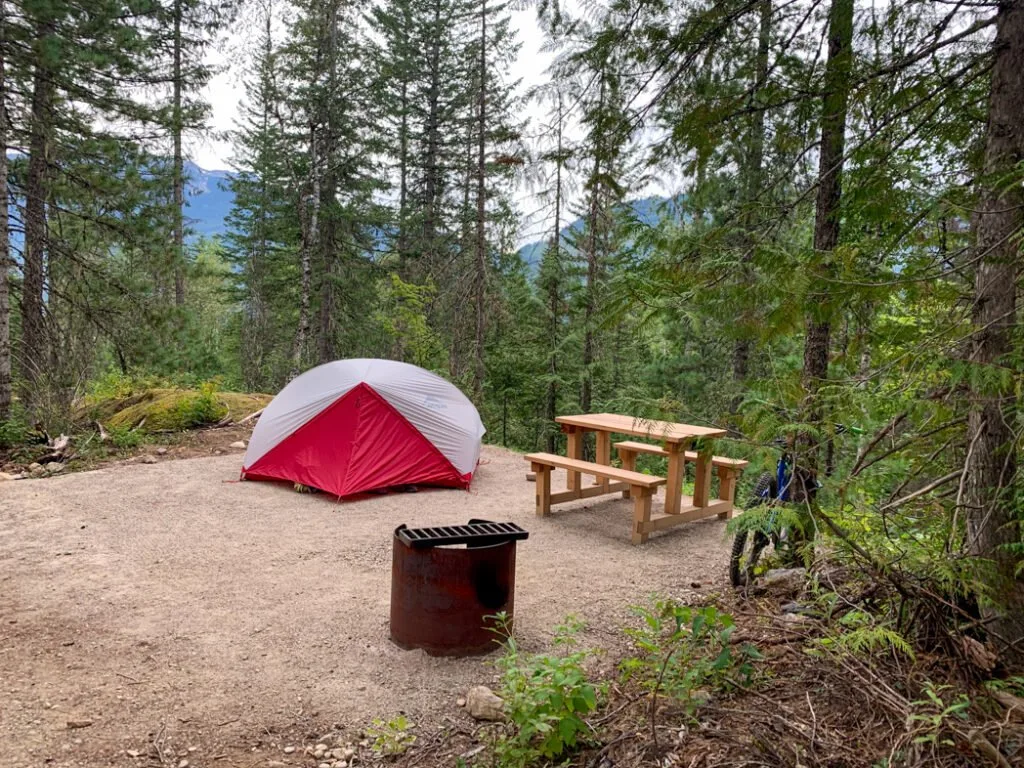
Final Thoughts
So that’s everything you need to know to stay warm in a tent. If you use these tips, you can have a great camping experience, even if it’s chilly out. Do you have questions about staying warm in a tent? Ask in the comments – I’m happy to help.
READ NEXT:
- Backpacking for Beginners: Tips for Getting Started
- Fall Backpacking Tips: How to Stay Warm and Have Fun
- What to Wear Winter Hiking and Snowshoeing
- 40+ Tips for Hiking in the Rain
- The Best (and Worst) Backpacking Meals Reviewed - December 16, 2025
- My Favourite Hiking Gear of 2025 - December 9, 2025
- Best Insulated Skirts For Hiking and Snowshoeing in 2026 - December 5, 2025


Janice
Wednesday 12th of April 2023
Putting a lamb skin under you really helps....
Dhiren@Trekology
Monday 5th of December 2022
This blog post was full of helpful and practical advice that I will make sure to use on my next camping trip. 🤩 One of the tips that really stood out to me was fighting condensation which can be done by pitching the tent tightly, and keeping the entrance partly unzipped when you're inside. I also found the suggestion of bringing a warm sleeping bag and an insulated sleeping pad incredibly useful. But my favorite tip is drinking hot beverages. 😉 Thanks for sharing such amazing tips with us!